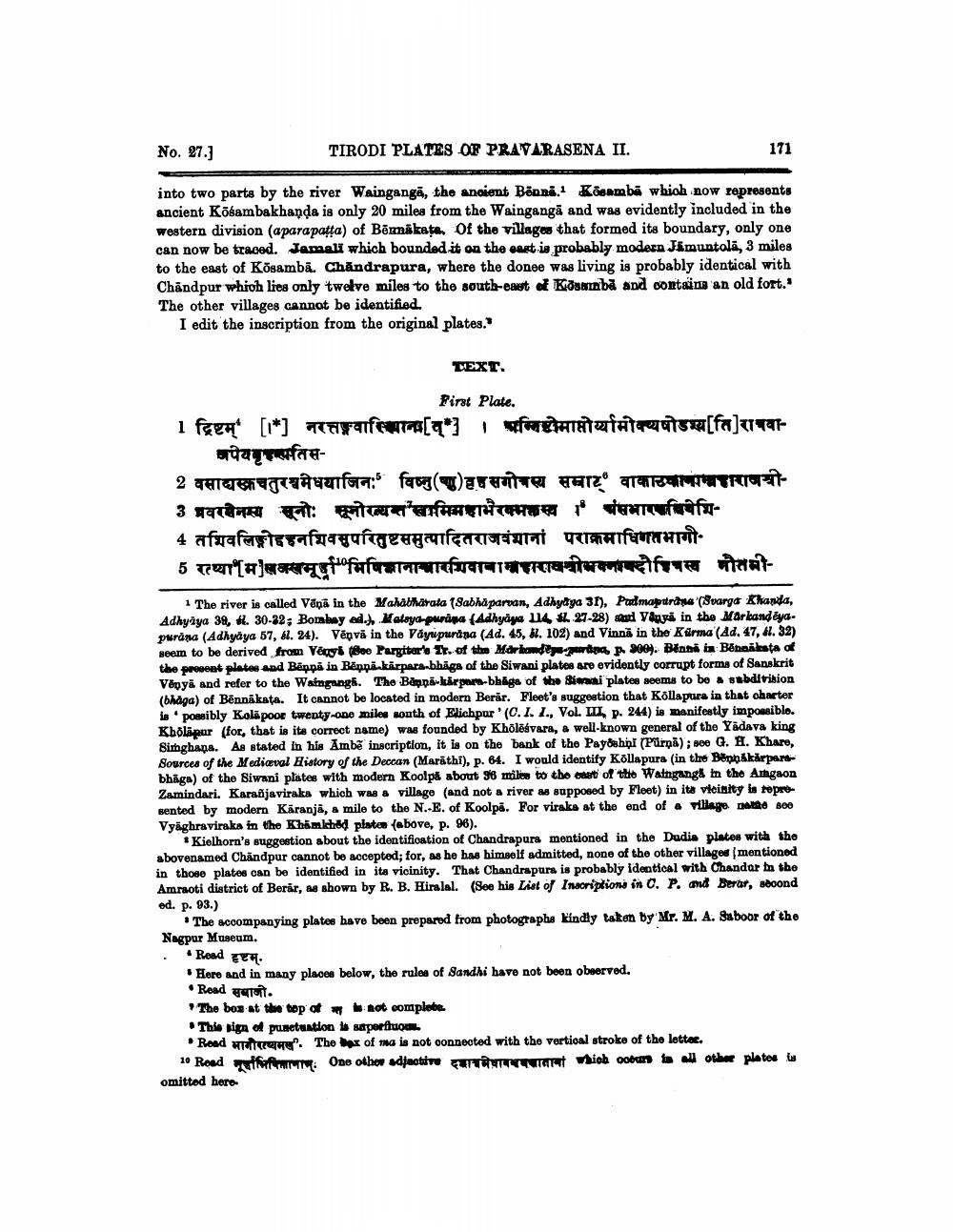________________
No. 27.]
TIRODI PLATES OF PRAVARASENA II.
into two parts by the river Waingange, the ancient Bennä. Kosamba which now represents ancient Kosambakhanda is only 20 miles from the Wainganga and was evidently included in the western division (aparapaṭṭa) of Bemakata. Of the villages that formed its boundary, only one can now be traced. Jamali which bounded it on the east is probably modern Jämuntola, 3 miles to the east of Kosamba. Chandrapura, where the donee was living is probably identical with Chandpur which lies only twelve miles to the south-east of Kosamba and contains an old fort." The other villages cannot be identified.
I edit the inscription from the original plates.
TEXT.
First Plate.
1 द्रिष्टम् [*] नरत्तङ्गवारियाना [त्*] । बिटोमाप्तोर्य्यामोक्यषोडश्य [ति] रात्रवाअपेववृपतिस
2 वसाद्यस्क्रचतुरश्वमेधयाजिनः विष्णु (ष्णु) वृहसगोत्रस्य सम्राट' वाकाटकानान्महाराजश्री - 3 प्रवरमेनस्य चुनो मोयन्तखामिमहामेरयमस्य सभारकविधि
4 तशिवलिङ्गोद्दहन शिवसुपरितुष्टसमुत्पादितराजवंशानां पराक्रमाधिगत भागीमिविज्ञानान्तारशियाचा खचारायचीभवनाबदोश मोती
5 [त्या]]]
171
1 The river is called Vena in the Mahabharata (Sabhaparvan, Adhyaya 31), Padmapurana (Svarga Khanda, Adhyaya 38, . 30-22; Bombay ed.), Matsya-purana (Adhyaya 114, 1. 27-28) and Vanya in the Markandeyapurana (Adhyaya 57, 61. 24). Vēņva in the Vayupurana (Ad. 45, l. 102) and Vinna in the Karma (Ad. 47, 61.32) seem to be derived from Venys (See Pargiter's Tr. of the Markandpa-partna, p. 300). Binnä in Bönnäkata of the present plates and Bappa in Beņņā kārpara-bhāga of the Siwani plates are evidently corrupt forms of Sanskrit Venya and refer to the Waingangs. The Boppa-kärpara-bhaga of the Siwani plates seems to be a subdivision (bhaga) of Bennakata. It cannot be located in modern Berar. Fleet's suggestion that Kollapura in that charter is possibly Kolapoor twenty-one miles south of Elichpur' (C. I. I., Vol. III, p. 244) is manifestly impossible. Kholapur (for, that is its correct name) was founded by Kholeśvara, a well-known general of the Yadava king Simghapa. As stated in his Ambe inscription, it is on the bank of the Payoshini (Pürna); see G. H. Khare, Sources of the Mediaval History of the Deccan (Marathi), p. 64. I would identify Köllapura (in the Beppäkärpara bhaga) of the Siwani plates with modern Koolpa about 36 miles to the east of the Waingangs in the Amgaon Zamindari. Karañjaviraka which was a village (and not a river as supposed by Fleet) in its vicinity is represented by modern Karanja, a mile to the N.-E. of Koolpa. For viraka at the end of a village nethe see Vyaghraviraka in the Khamkhed plates (above, p. 96).
Kielhorn's suggestion about the identification of Chandrapura mentioned in the Dudia plates with the abovenamed Chandpur cannot be accepted; for, as he has himself admitted, none of the other villages (mentioned in those plates can be identified in its vicinity. That Chandrapura is probably identical with Chandar in the Amraoti district of Berar, as shown by R. B. Hiralal. (See his List of Inscriptions in C. P. and Berar, second ed. p. 93.)
The accompanying plates have been prepared from photographs kindly taken by Mr. M. A. Saboor of the Nagpur Museum.
Read
Here and in many places below, the rules of Sandhi have not been observed.
• Read सबाजी.
The box at the top of is not complete.
This sign of punctuation is saperfluous.
• Read
me. The box of ma is not connected with the vertical stroke of the letter.
10 Road मूभिषितानाम्: One other adjective दावमेधानभवजातानां which ooburs in all other pleton is omitted here.




